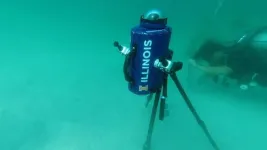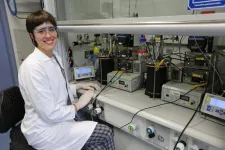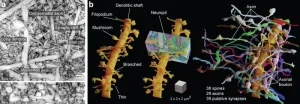(Press-News.org) University of Illinois Urbana-Champaign researchers have developed a novel method for underwater geolocalization using deep neural networks that have been trained on 10 million polarization-sensitive images collected from locations around the world. This new study, led by electrical and computer engineering professor Viktor Gruev, along with computer science professor David Forsyth, enables underwater geolocalization using only optical data while providing a tool for tethered-free underwater navigation.
These findings were recently published in the journal eLight.
“We are showing for the first time, you can geolocate yourself, or a camera, in a number of different conditions, whether in open ocean waters, clear waters or low visibility waters, at day, at night, or at depth,” says Gruev. “Once you have a sense of where you are, then you can start exploring and use that information to have a better understanding of the underwater world or even how animals navigate.”
Gruev explains that one of the main challenges with underwater navigation and geolocalization is that GPS signals cannot penetrate water- they bounce off the surface. “We are blind in terms of GPS signals underwater. We need to use different means and different technology for geolocating underwater.”
The current standard for geolocalization is using acoustic information, mainly obtained by sonar technology. This works by deploying many little sonar beacons which send signals that are triangulated to locate an object underwater. The issue, however, is that sonar only works in a small, defined area, while also being limited by its accuracy.
Another method currently utilized is using submersibles that are tethered to a larger vessel above the surface that has a GPS signal. Although the submersible can maneuver a little bit, it is ultimately limited by the movement of the vessel.
“It is an incredibly challenging problem to have a free-moving, underwater vehicle. The way we solve this problem is by developing specialized cameras and machine learning algorithms. By combining those, we can actually figure out the sun’s location and this is where polarization imaging comes into play.” -- Victor Gruev
Light waves from the sun move in all directions-it is unpolarized. When those waves pass through a filter, like the water’s surface, they are forced to move in only one direction-the light has been polarized. Polarization patterns are the result of light’s transmission from the air to the water and scattering by water molecules and other particles. The patterns underwater change throughout the day, and they depend on the location of both the observer and the sun. By analyzing these patterns alongside accurate date and time information, it is possible to then determine location.
The team collected ~10 million images with an underwater camera and an omnidirectional lens capable of recording the polarization patterns from four sites: a freshwater lake in Champaign, IL (visibility around 0.3 m), coastal sea waters in Florida Key, FL (visibility around 0.5-3 m), sea water in the bay of Tampa, FL (visibility around 0.5 m), and a freshwater lake in Ohrid, North Macedonia (visibility exceeding 10 m). Images were taken in a variety of conditions (clear vs murky waters), depths, and times of the day- even at night when underwater light intensity is significantly weaker.
“We think of life as dull if we can’t see anything, if we cannot see the hands in front of us. But if we can see polarization properties of light, we can geolocate, even in muddy waters. And actually, life is pretty rich in terms of polarization,” Gruev says.
These images were used to train a neural network-a method of artificial intelligence to learn and improve accuracy over time. “The way we did this was to collect 10 million images of the sun from underwater,” Forsyth explains. “Each image was tagged with where it was taken, and the elevation of the sun. Those images were then passed into a learning system and the system was adjusted until it gave a precise location.” Using these machine learning techniques has helped improve location accuracy to 40-50 km, with the possibility of improving accuracy even further.
This technology presents new opportunities for people and robots to navigate underwater. Oceans account for over 70% of Earth’s surface area, yet very little is known about it. Data we do know about these bodies of water comes from monitoring via satellites 20-30 miles above the surface. In situ autonomous sampling robots could provide more precise monitoring of water properties such as water temperature, salinity, oxygen levels and other related parameters.
The recent OceanGate Titan submersible search and rescue efforts have highlighted the need for accurate geolocation abilities. In order to locate the submersible at any possible depth, efforts were split into two distinct regions, near the ocean surface and near the seafloor, due to the limitations of current technology. Deep water efforts are significantly more challenging than near-surface operations, which have more technological options, and rely mainly on sonar. Not only is sonar unreliable over a large area, but it also often creates echoes that conceal an object’s precise location. Gruev says, “This polarization imaging technology will enable smaller autonomous robots to roam around the first 200-300 meters where light penetrates into the water and where our technology works very well and can help during search and rescue missions.”
"It is difficult to understand just how big the oceans are, how much water there is, how far away from anything you can be, and how hard it is to find anything out there. The biggest technological problem, up until the early 19th century, was simply knowing where you were at sea. And it remains really, really difficult." --David Forsyth
Viktor Gruev is also an affiliate of Beckman Institute for Advanced Science and Technology, the Department of Bioengineering and the Carle Illinois College of Medicine at UIUC.
Other contributors to this work include Xiaoyang Bai (Department of Electrical and Computer Engineering at UIUC), Zuodong Liang (Department of Electrical and Computer Engineering at UIUC), Zhongmin Zhu (Department of Electrical and Computer Engineering at UIUC) and Alexander Schwing (Department of Electrical and Computer Engineering and Department of Computer Science at UIUC).
This research was funded by the Office of Naval Research and U.S. Air Force Office of Scientific Research.
END
Navigating the future of underwater geolocalization: how polarization patterns enable new technology
2023-07-10
ELSE PRESS RELEASES FROM THIS DATE:
Anastasopoulos receives funding for EAGER: building language technologies by machine reading grammars
2023-07-10
Antonios Anastasopoulos, Assistant Professor Computer Science, received $99,294 from the National Science Foundation for: "EAGER: Building Language Technologies by Machine Reading Grammars." This funding began in June 2023 and will end in late May 2024.
Anastasopoulos said, "This project aims to explore the feasibility of building language technologies while bypassing the need for exorbitant amounts of data, instead turning to already-codified linguistic knowledge. This is of particular importance for bridging the language technology gap for underserved communities: ...
Ungvari & Nichols securing core support for International Global Change Research
2023-07-10
Judit Ungvari, Research and Innovation Officer, Institute for a Sustainable Earth, and Leah Nichols, Executive Director, Institute for a Sustainable Earth, Research and Innovation Initiatives, received $277,602 from the National Science Foundation for: "Collaborative Research: Core Support for Future Earth International Global Change Research."
The grant will provide salary to support Ungvari’s work, travel funds, and support costs for participants to attend annual Sustainability Research and Innovation congresses where the Future Earth assembly occurs.
This funding began in May 2023 and will end ...
Conservation in Indonesia is at risk, a team of researchers who study the region argues
2023-07-10
Indonesia, home to the largest tropical rainforest in Southeast Asia and over 17,500 islands, is a country packed with biodiversity and endangered species. However, scientists studying the region’s species and ecosystems are getting banned from Indonesia, and conservation plans are being blocked. In a letter publishing in the journal Current Biology on July 10, a team of conservation researchers with long-term experience in Indonesia discuss scientific suppression and other research challenges they have witnessed while working in the region. They offer suggestions for how to promote nature conservation, protect data ...
Breathing poison: Microbial life on nitric oxide respiration
2023-07-10
Nitric oxide (NO) is a fascinating and versatile molecule, important for all living things as well as the environment. It is highly reactive and toxic, organisms use it as a signaling molecule, it depletes the ozone layer in our planet’s atmosphere, and it is the precursor of the greenhouse gas nitrous oxide (N2O). Moreover, NO might have played a fundamental role in the emergence and evolution of life on Earth, as it was available as a high-energy oxidant long before there was oxygen.
Thus, despite its toxicity, it makes perfect sense that microbes use NO to grow. However, research on the topic is scarce and, to date, microbes growing on it have not been cultivated. ...
Study shows same-sex sexual behavior is widespread and heritable in macaque monkeys
2023-07-10
Observations of a wild colony of macaques over three years show same-sex sexual behaviour among males is widespread and may be beneficial.
The results, published today in Nature Ecology and Evolution, suggest same-sex sexual behaviour (SSB) has evolved and may be a common feature of primate reproduction.
Conducted by researchers at Imperial College London, the observations and genetic data form the first long-term study of SSB in males within one species. Their study challenges the beliefs of some that SSB is a rare behaviour in non-human ...
GPT detectors can be biased against non-native English writers
2023-07-10
In a peer-reviewed opinion paper publishing July 10 in the journal Patterns, researchers show that computer programs commonly used to determine if a text was written by artificial intelligence tend to falsely label articles written by non-native language speakers as AI-generated. The researchers caution against the use of such AI text detectors for their unreliability, which could have negative impacts on individuals including students and those applying for jobs.
“Our current recommendation ...
Record-breaking heat in the summer of 2022 caused more than 61,000 deaths in Europe
2023-07-10
The summer of 2022 was the hottest summer ever recorded in Europe and was characterised by an intense series of record-breaking heat waves, droughts and forest fires. While Eurostat, the European statistical office, already reported unusually high excess mortality for those dates, until now the fraction of mortality attributable to heat had not been quantified. This is precisely what has been done in a study led by the Barcelona Institute for Global Health (ISGlobal), a centre supported by the "la Caixa" ...
LIONESS redefines brain tissue imaging
2023-07-10
Brain tissue is one of the most intricate specimens that scientists have arguably ever dealt with. Packed with currently immeasurable amount of information, the human brain is the most sophisticated computational device with its network of around 86 billion neurons. Understanding such complexity is a difficult task, and hence making progress requires technologies to unravel the tiny, complex interactions taking place in the brain at microscopic scales. Imaging is therefore an enabling tool in neuroscience.
The new imaging and virtual reconstruction technology developed by Johann Danzl’s group at ISTA is a ...
Racial, ethnic differences in factors associated with delayed or missed pediatric preventive care due to the pandemic
2023-07-10
About The Study: In this cross-sectional study, more than one-fourth of children had delayed or missed preventive care due to the COVID-19 pandemic. These findings may guide targeted interventions to enhance timely pediatric preventive care among different racial and ethnic groups.
Authors: Maya Tabet, Ph.D., M.S., of the University of Health Sciences and Pharmacy in St. Louis, is the corresponding author.
To access the embargoed study: Visit our For The Media website at this link https://media.jamanetwork.com/
(doi:10.1001/jamanetworkopen.2023.22588)
Editor’s ...
Association between pandemic and early childhood development
2023-07-10
About The Study: The findings of this study showed an association between exposure to the COVID-19 pandemic and delayed childhood development at age 5. Variations in development widened during the pandemic regardless of age. It is important to identify children with developmental delays associated with the pandemic and provide them with support for learning, socialization, physical and mental health, and family support.
Authors: Koryu Sato, M.P.H., of Kyoto University in Kyoto, Japan, is the corresponding author.
To access the embargoed ...





